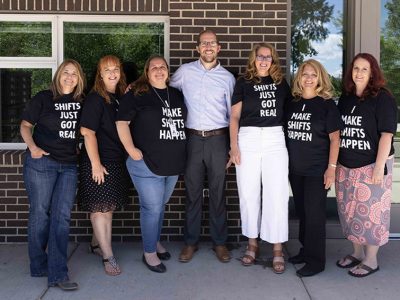In December 2020, Community Solutions launched a pilot project with the Institute for Healthcare Improvement (IHI) to explore the critical role that health care systems can play in helping communities end chronic homelessness. Community Solutions is a nonprofit using data to end homelessness and an IHI Strategic Partner.
Through the pilot, leaders from the health care and homelessness response systems came together to accelerate progress in five communities across the country. These include:
- Bakersfield/Kern County, California, in partnership with Kaiser Permanente and CommonSpirit Health
- Washington County, Oregon, in partnership with Kaiser Permanente and Providence Health System
- Sacramento County, California, in partnership with Kaiser Permanente, CommonSpirit Health, UC Davis Health, and Sutter Health
- Anchorage, Alaska, in partnership with Providence St. Joseph Health
- Chattanooga, Tennessee, in partnership with CommonSpirit Health
These health systems have embraced the fact that health extends beyond the delivery of medical care, especially to the work of solving homelessness. For Betsy Kammerdiener, the Market Director of Mission Integration at CHI Memorial Hospital in Chattanooga, promoting better housing outcomes for unhoused neighbors is part of that charge.
“Studies show that folks have a shorter life expectancy, 10-20 years shorter, because they are chronically homeless,”
Betsy Kammerdiener
Kammerdiener shared, “there is a health gap. When they come to our emergency room, we are doing the best health care we can, but if we are treating them within our health care system, and discharging them back into homelessness, all of our progress is truncated because we are not able to do the follow up we need.”
For the past year, CommonSpirit Health and the homelessness response system in Chattanooga have been working together to deliver better health and housing outcomes for those experiencing homelessness, while addressing shared challenges and bridging gaps.
“Health care is so much more than what happens within the walls of our hospital,” Kammerdiener said.
Establishing Foundations
According to Chattanooga housing advocates, the COVID-19 pandemic has been a pivotal moment to understanding that the health and homeless systems closely affect one another.
“A week before the shelter-in-place orders went into effect, health officials invited us to come into a meeting,” said Wendy Winters, the Executive Director for the Chattanooga Regional Homeless Coalition.
“We found ourselves in this role of making decisions that directly affect people’s health and it was just a very odd situation to be in. Through those partnerships and dealing with COVID, we learned a lot,” shared Winters. In both sectors, there was “an awakening and public acknowledgements in really big ways that housing is health care.”
Since the beginning of the pilot in 2020, the two systems have built a closer relationship by developing common aims and clearer communication.
“Both homeless services and health care have short hand language, terms and acronyms that we use in our work,” said Anna Bialik, System Improvement Advisor with Community Solutions. “When we reach outside of our systems, we have to decode our terminology so that we can understand each other and begin to build a common language.”
Bialik believes that by connecting across sectors, health care partners can help resolve homelessness as a system failure.
“We should design our systems, services, and programs to meet clients where they are at and as whole people,” said Bialik. “This means collaborating to build bridges between systems so no one falls through cracks.“
Shared Challenges
Three years ago, the community of Chattanooga never saw folks aging into chronic homelessness.
“We [used to see] more people hitting the system as [experiencing chronic homelessness],” said Jamie Ascarate, a Coordinated Entry Manager for the Chattanooga Regional Homeless Coalition. Now, however, “we have more people aging into chronicity rather than hitting the system as chronic.”
Housing agencies in Chattanooga often struggle to quickly locate affordable housing, which creates bottlenecks to housing pathways in the system. Through shared aims, health and housing partners now identify barriers to cohesive care and work against homelessness as a public health issue.
“Housing is health care,” affirmed Kammerdiener, who has plans for her team to involve themselves in Chattanooga’s housing crisis by advocating for more affordable units in Chattanooga. “We’ll have to be somehow involved in this development of housing. Affordable housing has such a social justice component, and if we don’t have housing we’re not going to be any farther down the road.”
“People get so ill they cannot support themselves.”
Jamie ascarete
According to Ascarate, folks facing the broken system “go to the hospital for months, get evicted, and if they had help with housing, this would be solvable, this would not happen. The resources are definitely there. We just have to put it all together to reach functional zero. We will never be able to reach it if we don’t have the capacity for it.”
Functional zero is measured when homelessness is rare, brief, and sustained over time. For chronic homelessness, the milestone is defined when the number of actively homeless individuals is fewer than 3, or 0.1% of the last point-in-time count, whichever is greater.
Strengthening Systems for Better Housing and Health Outcomes
Kammerdiener has observed that the growing relationship between health care and homelessness stakeholders has equipped both to better address the health and housing needs of those they serve.
“We have been able to create an organic sharing of information and a sharing of data needed to make sure folks coming into the hospital from the system are identified early and are provided with the services they need,” she said.
Both partners have recognized that there are cost savings, better outcomes, and moral and ethical reasons to collaborate to end homelessness at a population level. With a commitment toward systems redesign across health care and homelessness, partners are able to treat homelessness as an issue of health care delivery and reduce its impact in communities.
Ascarate described examples of people who were better supported by health and homeless systems through the partnership. “We had a few folks who were going to be discharged onto the streets unable to walk,” Ascarate said. “We referred them to housing agencies and a housing plan was cobbled together for them so that rehab would take them.”
“Somebody else was in and out of 72-hour holds. We were able to find a mental health-supported group home. The health care system allowed him to get the medical documents to get him qualified for housing,” Ascarate said.
A collaboration across sectors of health care and homelessness can bring forth improvements across both systems, while establishing practices of care for those in the community who need the most support.




